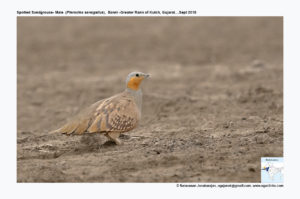Spotted Sandgrouse

Spotted Sandgrouse Pterocles senegallus
Etymology:
- Pterocles :Greek word pteron -wing; kles – notable, splendid
- Senegallus: From Senegal in Africa
Vernacular Names: Baluchistan: Likhirik, Sind: Nanhokatingao, Kara pet gutu, Gutu, Guj: Waku-waku, Kachchibatavdo, Kutch: Waku
Distribution in India: Breeds in Rajasthan , winter visitor in North West India.
Description: It has a size of 30–35 cm; wt. of 250–340 g; wingspan of 53–65 cm. It is the only Sandgrouse with elongated central rectrices lacking colour separation on breast. It has a diagnostic longitudinal black stripe on belly, more conspicuous during flight; dark trailing edge of wing. The throat and sides of head are ocher or orange-yellow, paler in female. The orbital ring is yellow; bill is bluish. There are dark spots on breast and upperparts of female, difficult to see from a distance. The juvenile has short tail feathers, white throat and barred and streaked upperparts. Birds from Pakistan and India are usually slightly paler and more greyish.
Habitat: It is found in sparsely vegetated semi-desert and desert, with patches of vegetation.Drinking water is required nearby. It usually avoids thick scrub, trees and arable land, occupying both stony and sandy areas.
Food habits: It eats primarily small, hard seeds such as barley. It feeds mostly during morning or late afternoon. It drinks during morning, 06:30–08:00 hours.
Breeding habits: They breed in Mar–Jul. The nest is a scrape or natural depression on ground. They use hoof-marks of cattle, or near a stone. They lay a clutch of 3 eggs. The incubation is 29–31 days, with male sitting by night. Only 2 young reared.